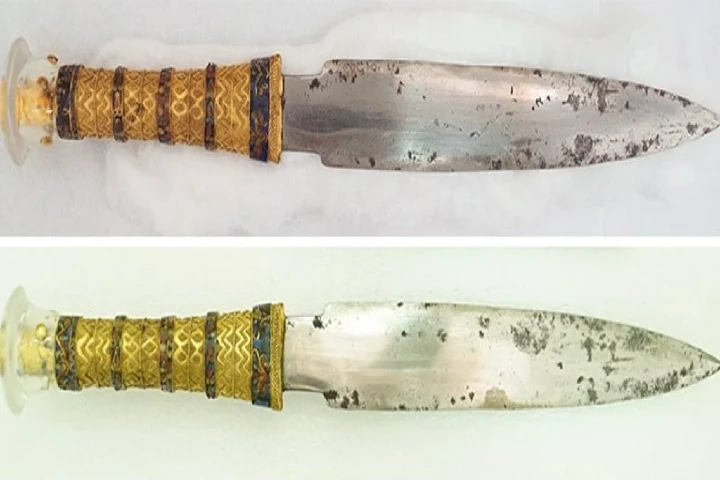

Recent study of the King Tutankhamen's dagger has brought to light new aspects about how it was made and the material used (Pic. Courtesy sciencealert.com)
<p>
<strong>The space dagger — made with meteorites&rsquo; rocks — entombed with King Tutankhamen has always been an enigma for historians and archaeologists. Now a new study brings to the fore several interesting aspects about this captivating artefact says a report in sciencealert.com.</strong></p>
<p>
Using modern scientific tools like high-resolution photography and X-rays for analysis has unveiled the type of meteorite used to make the dagger and how it was made.</p>
<p>
Interestingly, the research also suggested that the dagger may not have been made in Egypt and was gifted to King Tutankhamen or one of his ancestors.</p>
<p>
Sharing details of the study, Tomoko Arai, Chiba Institute of Technology, Japan&rsquo;s planetary scientist told Gizmodo: <a href="https://www.sciencealert.com/the-mysterious-origins-of-king-tutankhamen-s-space-rock-dagger-just-got-clearer?utm_source=ScienceAlert+-+Daily+Email+Updates&amp;utm_campaign=1e71176c8d-MAILCHIMP_EMAIL_CAMPAIGN&amp;utm_medium=email&amp;utm_term=0_fe5632fb09-1e71176c8d-366100389">&quot;To understand the manufacture and origin</a> of the dagger, we conducted on-site non-contact, non-destructive two-dimensional chemical analysis for the dagger. We noticed a cross-hatched texture present in places for the both sides [of the dagger], suggesting Widmanst&auml;tten structure, typical of [an] octahedrite iron meteorite. That was our WOW moment.&quot;</p>
<p>
The octahedrite iron meteorites are the most common type of iron meteorites.</p>
<p>
It is only by using a relatively low temperature forging technique can this pattern be preserved. Experts feel that the object was cast at temperatures under 950 degrees Celsius. Any increase would have resulted in the disappearance of the pattern.</p>
<p>
The sulphur-rich areas which are indicated by black spots on the blade and inside a crack on its surface are likely to have been brought about by heating of iron sulphide mineral that is present in iron meteorites or troilite. This points to the origin of the object.</p>
<p>
The hilt of the dagger was subjected to analysis which showed that its decorative stones were probably fixed with lime plaster. This method was not used in Egypt at that time and came to the region much later, thereby indicating that the object came from outside.</p>
<p>
<strong>Also read: <a href="https://www.indianarrative.com/culture-news/ancient-egyptians-celebrated-peace-and-prosperity-of-king-amenhotep-iii-in-grand-style-145515.html">Ancient Egyptians celebrated peace and prosperity of King Amenhotep III in grand style</a></strong></p>
<p>
Dealing with this issue, the researchers pointed to the Amarna letters &ndash; a collection of ancient Egypt diplomatic correspondence dating from 1360-1332 BCE &ndash; in which there is reference to an iron dagger given as present to one of Tutankhamen&#39;s ancestors.</p>
<p>
In the paper, the researchers mentioned: &quot;[The] gold hilt hints at [the dagger&#39;s] foreign origin, possibly from Mitanni, Anatolia, as suggested by one of the Amarna letters saying that an iron dagger with gold hilt was gifted from the king of Mitanni to Amenhotep III, the grandfather of Tutankhamen.&rdquo;</p>
<p>
<strong>Also read: <a href="https://www.indianarrative.com/culture-news/year-old-mummy-spotlights-indigenous-communities-in-peru-134809.html">800-year-old Mummy spotlights indigenous communities in Peru</a></strong></p>
<p>
Most iron objects before the advent of Iron Age and its technologies were made from fragments of meteors and the process involved for this is sure to have included a lot of trial and error.</p>
<p>
Expressing his views about this to Asahi Shimbun, professor of cultural properties science at the National Museum of Japanese History in Japan, Tsutomu Saito said: &quot;[The study] provides evidence that ancient people had achieved the conditions that we predicted scientifically. This is an important finding that shows the starting point of mankind&#39;s quest to develop iron manufacturing technology.&quot;</p>
<p>
Saito, who was not part of the study, has researched on iron forging that predates the Iron Age, added that craftsmen then used experience and instinct to guide them while making an object.</p>
<p>
The research has been published in a peer-reviewed journal Meteoritics &amp; Planetary Science.</p>
Taiwan's Ministry of National Defense detected four Chinese naval vessels operating around its territorial waters…
India abstained from voting on the United Nations General Assembly (UNGA) resolution on the situation…
By Shalini Bhardwaj A government-appointed expert committee in Karnataka has found no evidence linking COVID-19…
BRICS leaders convened in Rio de Janeiro for the 17th BRICS Summit from July 6…
Vietnam's Ambassador to India, Nguyen Thanh Hai, highlighted the strong cooperation between Vietnam and India,…
Leaders of the BRICS nations welcomed Indonesia as a member of the group, while 10…